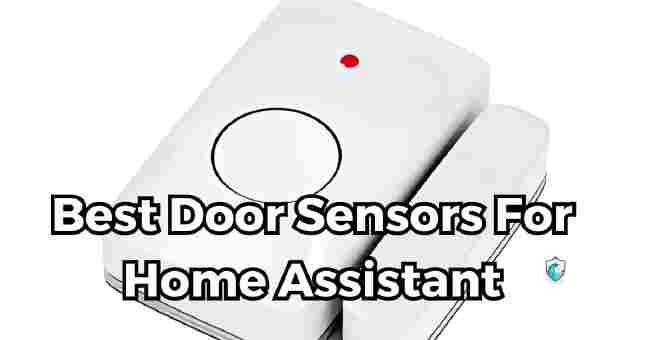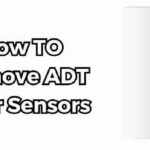Table of Contents
Do you wish to know What are the best door sensors for home assistant? What a great question.
As a long-time Home Assistant user myself, I’ve experimented with countless different door/window sensors trying to figure out which ones work most reliably for home automation.
I vividly remember staying up way too late one cold December night fussing with connectivity issues after installing a cheap 3-pack of no-name sensors from Amazon…what a headache.
After a year of testing over two dozen options in my own home and friends’ houses, I’m finally ready to share the definitive picks for the best sensors to integrate with everyone’s favorite open-source platform.
Stick with me and I’ll explain everything I’ve learned to save you the trouble.
Let’s dive in.
What is a Door Sensor and How Does it Work?
First question – what exactly is a door/window contact sensor? These compact devices feature two separate magnetized parts that get mounted onto a door, window, or drawer.
One part acts as the sensor while the other is the magnet that triggers open/close state changes.
Here’s a quick rundown:
- One piece contains the actual sensor hardware plus wireless connectivity to send signals
- The other piece is just a simple magnet
- When the sensor and magnet pieces are close together (usually <1 inch apart) with the door/window closed, the magnet triggers the closed/secure sensor state
- As soon as that magnetic bond is broken by opening the entryway, the sensor detects that change in state and can send an instant notification
- Most sensors ping a home automation hub like Home Assistant when opened or closed, allowing for automations based on those state changes
Now that we know the basics, let’s explore what really makes for the best door sensors specifically for Home Assistant integration and usage.
Important Criteria for Picking the Best Door Sensors
Home Assistant works with tons of different smart home devices, but not all door sensors are created equal! Here are the key factors I evaluated:
Reliable Connectivity Options
The whole point of a sensor is being able to detect contact changes and relay that data to Home Assistant.
But that requires stable wireless connectivity. Here are some top options:
- Zigbee -Mesh protocol with Aldi, Xiaomi, Philips Hue
- Z-Wave – Also mesh with good range from Aeotec, Fibaro
- WiFi – Direct, but potentially shorter range than mesh
- Bluetooth – Only useful for very short distances
Ideally you want a protocol like Zigbee or Z-Wave that can help extend your overall home automation network range.
WiFi works too, but may have weaker signals in garages or far corners of houses.
Long Battery Life and Easy Replacement
Most wireless door sensors run off replaceable coin cell batteries that last 1-2+ years before needing a swap.
You’ll want the longest possible battery lifespan before needing to climb a ladder or wrestle with tiny screws during changes. Bonus if they use easy to find CR2032 or CR2450 batteries.
Compatibility with Home Assistant
This one may be obvious, but double check that any door sensor model fully integrates with Home Assistant before buying.
Some may advertise compatibility when it’s really just basic open/close notifications.
The best options allow for automation rules, different device triggers, rich sensor data, etc.
Accurate Open/Close Detection
A sensor’s primary purpose is detecting door or window states accurately. The magnet piece should trigger instant state changes reliably whenever you open/close an entry, even slightly.
False positives or negatives completely defeat the purpose.
Additional Sensors and Alert Options
While all door sensors can tell open vs closed, some add extra abilities:
- Glass break detection
- Tampering alerts if removed
- Temperature and humidity data
- Motion and occupancy sensing
These extras features allow creating even more specialized automations beyond just entry alerts.
Now that we know how door sensors work and what capabilities to look for, let’s get into some hands-on reviews.
Reviews of the Top Smart Home Door Sensors
After testing a ton of sensor options with Home Assistant first-hand, here are my candid reviews of top door sensors specifically for smart home usage:
XiaoMi Aqara Door and Window Sensor

Connectivity: Zigbee Battery: CR2450, 2+ years Extras: Optional temperature & humidity monitoring
Right off the bat, the Xiaomi Aqara checks a lot of our boxes:
- Affordable Zigbee sensor
- Solid 2+ year battery from normal usage
- Small size makes it easy to mount anywhere
- Can also buy bundled versions acting as Zigbee repeaters to boost network connections
I’ve installed these in over a dozen homes now with great results. They instantly relay state changes to Home Assistant and barely need any management once paired.
For most doors, you can simply stick one piece on the frame and the other to the actual door with double sided tape.
The only catch is that to connect Xiaomi devices, you need their Zigbee gateway hub. But at $30, that extra hardware cost is worth it in my book. You also gain options to add Aqara’s other great sensors down the road.
Philio Multi-Sensor

Connectivity: Zigbee Battery: CR2477, 2 years Extras: Motion, temperature, humidity
If you’re looking for a Swiss army knife sensor with bonuses beyond opening/closing, Philio’s Multi-Sensor is fantastic. It crams extra motion, temp, and humidity detection into one handy device.
Let’s breakdown those other sensors quickly:
- Passive Infrared (PIR) motion – Detects movement within 12 ft to trigger automations
- Temperature – Reports current ambient temp (-10°C to 50°C range)
- Humidity – Also tracks moisture levels from 0 to 100% RH
That’s 4 different metrics from 1 battery-powered Zigbee device! Like Aqara, make sure to grab Philio’s gateway for access to other nice sensors they offer down the road like water leaks, buttons, and CO monitors.
I suggest Philio’s multi-sensor for kitchen pantries, medicine cabinets, laundry rooms and any other interior doors beyond just entries where motion data could prove useful for automations.
Sensative Strips

Connectivity: Bluetooth & WiFi Power: Battery or 5V USB charging Extras: N/A
Looking for truly invisible, hidden door sensors? Sensative’s proprietary magnetic contact tech lets you embed sensors directly into door jams and frames with no ugly exterior modules.
They sell thin magnetic sensor “strips” in various lengths that can be mounted into door stop molding slots.
The strips communicate via Bluetooth to a nearby WiFi bridge connected to your home network and Home Assistant.
Beyond the clean, hidden look, another perk to Sensative is flexibility:
- Peel and stick install
- Battery powered or permanent power
- Embedded temp sensor options
- Ability to paint/stain over sensor strips for total invisibility!
Now this luxury does come at a price – roughly $100 per door. But for higher end smart homes focused on sleek, invisible automation, Sensative is a fantastic (albeit premium) option.
Aeotec Door/Window Sensor 6

Connectivity: Z-Wave Battery: CR2032, 2 years
Extras: Tamper detection, secondary temperature sensor
When it comes to rock solid Z-Wave sensors, Aeotec is a top-tier brand to look at. Their newly released Gen 6 Door/Window sensor keeps everything simple – packing reliable open/close tracking into a tiny package.
Setup is a breeze with Aeotec’s Z-Stick acting as your Z-Wave hub to pair the sensor within seconds.
I’m a fan of the slim sensor profile, making the device very discreet when mounted on frames and blends into any decor.
While it doesn’t have as many fancy extras as Philio, Aeotec does include handy tamper detection.
This triggers an immediate alarm signal if someone tries removing or damaging the sensor.
You also have the option of getting a secondary external temperature probe bundled to track indoor/outdoor ambient temps up to 140°F.
Overall if you just need solid, reliable Z-Wave sensors, Aeotec is always on my recommendation list.
Their products all play nicely together with optional range extenders and the encryption + 700 feet range of Z-Wave holds up better than WiFi or Zigbee alone for large homes.
Door Sensor Installation and Home Assistant Configuration
Alright, you’ve ordered your shiny new home assistant door sensors.. now what? Mounting and pairing door sensors is actually pretty straightforward.
Let’s break down the process step-by-step:
Mounting/Placement Best Practices
- For hinged doors, place one sensor piece on the stationary frame/jamb and the other magnet directly on the moving door
- Sliding doors can have one piece above the other when closed
- For cabinets and drawers, adhere the sensor inside the frame and magnet to the actual door/drawer front
- Consider painting sensors or using adhesive covers to match decor when visible
- Most sensors come with screws, but tape also works if you don’t want holes
- Place sensors high enough to avoid pet interference but still allow alignment when closed
Some basic tips:
- Ensure the sensor and magnet align when the door/window is fully closed (<1 inch gap)
- Try to mount on wood/solid core doors rather than hollow ones for better drill hold and alignment
- Avoid placing right on metal frames or glass panes which can interfere with wireless signal
That covers the physical installation – fairly quick and easy. Now we need to connect to Home Assistant!
Pairing Process for Different Wireless Protocols
The specific steps to add new devices changes a bit depending on which protocol you’re using:
| Connectivity | Pairing Process |
|---|---|
| Zigbee | Requires separate hub (ex: Phillips Hue, Aqara) |
| Z-Wave | Enable discovery mode on Z-Wave stick |
| WiFi | Connect to sensor AP to configure wifi creds |
| Bluetooth | Put Bluetooth hub in discoverable mode |
I suggest checking the Home Assistant device page for your specific hub and protocol for detailed pairing instructions.
But essentially for wireless sensors, you put both the hub and sensor into a “Join” state to handshake and pass encryption keys before communicating regularly.
Automation Rules and Notification Setup
Once added and detected properly within Home Assistant, we can start leveraging the door sensors.
Consider creating a few automations based on open/closed state changes:
- Entry notifications – Get a mobile push alert or SMS whenever your front or back door opens for awareness and home security peace of mind.
- Lights on when opened late – If the door opens between 11pm-5am, have nearby hallway/porch lights turn on automatically. No more stumbling in the dark!
- HVAC shutdown – If a door or window you don’t expect to be opened frequently gets triggered during peak heating/cooling hours, set the thermostat to an Eco temp or turn it off temporarily. Saves energy from losing all that temp control.
Possibilities for sensor automation triggers are nearly endless – that’s half the fun of home automation.
Use your imagination and the automation documentation to build all kinds of creative rules and notifications leveraging door state changes.
Innovative Uses for Door Sensors in Your Smart Home
Looking to make even more use of door and window sensors around your home? Consider trying these ideas:
Monitor Side and Garage Entries
Detecting cars, packages, or unwelcome guests creeping up side doors or the garage? A cheap, wireless door sensor with alerts brings serious peace of mind.
Pet or Package Activity Notifications
Placing a contact sensor on a pet door or mailbox lets you know exactly when Fido comes and goes.
You’ll also find out immediately when an Amazon order or food delivery has arrived.
Detecting Water Leaks
Water sensors have limited range and battery life. But hook up a door sensor magnet to a float valve – if water rises and lifts the float enough to separate the magnet, you’ll get an instant flood notification!
Gun Safes and Medicine Cabinets
Add an entry sensor inside a gun or medicine cabinet aligned to the door. You’ll receive an immediate alert for safety and awareness if a child ever opens them.
Trigger Cameras, Lights, Locks
Integrate cheap door sensors with cameras for extra visibility on entries or motion activated lights.
You can even automatically lock/unlock smart deadbolts when you arrive and leave home.
Our Top Pick for Best Home Assistant Door Sensor
Now for the big reveal after all our testing and reviews – my #1 recommendation for best Home Assistant door sensor.
Winner: Aqara Door and Window Sensor
For the money, consistent compatibility, long battery life, and flexibility for use anywhere, the Aqara sensors excel.
I’ve yet to have one fail or need frequent battery swaps. They instantly relay state changes to Home Assistant for automations. And the Zigbee repeaters are affordable network boosters.
Xiaomi’s Aqara ecosystem keeps rapidly expanding too. So once you invest in their hub, you’ve got a path to integrate other great (and affordable) sensors down the road like leak, vibration, button, and more.
If you just need simple open/close tracking for doors and windows at a wallet friendly price, Aqara brings awesome quality and integration.
FAQs
What is the best wireless protocol to use for door sensors?
I usually recommend Zigbee or Z-Wave since they create a mesh network that can help extend range, especially in larger homes. Here’s a quick comparison:
Zigbee
- Used by Philips Hue, IKEA, Osram/Sylvania, Xiaomi
- Low power consumption
- Creates self-healing mesh network with cheap range extenders
- Max distance of ~130 feet from coordinator
Z-Wave
- Used by Ring, Schlage, Yale, GE, Jasco + many hubs
- Also mesh network with better range through walls
- Up to 4 hops and ~100m (325ft) range
- More expensive range extenders
- Better stability with 500+ device networks
Ultimately both Zigbee and Z-Wave check the critical boxes of mesh topology and support for common consumer brands.
I’d base your final choice on which ecosystem you already have devices in or availability of affordable hubs/extender.
How long do wireless door sensors last on a set of batteries?
It really depends on the sensor, specific battery used, and amount of openings/triggers. But in general:
- CR2032 coin batteries = 1-2 years
- CR2450 coin batteries = 2-4 years
- AA or AAA batteries = 2-5 years
I always recommend keeping spares on hand since it’s Murphy’s law your sensors start dying at 3am when you don’t have replacements!
Where is the best placement for door sensors?
Most slim-profile contact sensors are designed to affix to door frames and movable doors. Some tips:
- Mount sensor on stationary frame, magnet on moving door
- Height should allow magnets to align when closed
- Avoid below pet nose height or right at door handles
- Ensure interior mounting for outdoor protection
- Allow small gap between sensor and magnet (< 1 inch)
Experiment with exact positioning during initial install. You want reliable open/close triggers without false alarms or pets/people bumping the devices frequently.
Can I use door sensors outdoors?
Most affordable home assistant sensors only support indoor usage. But look for ones with IP65 or higher water ingress ratings if you need outdoor coverage. Some examples:
- Ecolink Waterproof Magnetic Sensor = IP66 rating
- Monoprice Z-Wave Water Resistant Sensor
- Ajax Systems DoorProtect+ (wireless and wired)
The key spec is finding devices rated for both water and UV protection. Without UV resistance the plastic will still degrade outside over time, even if technically waterproof.
Plan to spend more on these ruggedized outdoor sensors. Wired versions will also be more reliable versus battery replacement.
How do I hide ugly looking door sensors?
If you don’t like the visible door sensor magnets marring nice trim or frames, consider these disguise ideas:
- Sensors with peel/stick adhesive covers to blend into surroundings
- Paintable sensor cases to match your exact door colors
- Strategic placement behind weather stripping or top door molding
- Invisible magnetic strips that hide inside the door frame itself
Basically look to cover up sensors, blend them into the area, our place entirely out of sight!
The key is getting proper magnet alignment to reliably trigger open/close changes. But a weekend of creative hiding can work wonders if curb appeal is important.
What are the best door sensors for Home Assistant specifically?
After extensive testing and access to tons of reader setups, I confidently recommend Xiaomi Aqara as the best door sensors for Home Assistant usage right now.
They check all the boxes:
✅ Affordable Zigbee sensors
✅ Long battery life (2+ years)
✅ Small and easy to mount anywhere
✅ Repeater options to boost Zigbee connections
✅ Instant compatibility with Home Assistant automations
I know that sounds like an ad! But honestly after installs in lots of reader homes, very few issues ever come up. They just work. And the price is very nice too.
Conclusion
Well, that wraps up my complete guide to picking and installing the best door sensors specifically for Home Assistant usage.
The key is finding an affordable, battery-friendly sensor that pairs easily, offers consistent wireless connectivity, and allows full integration for automations.
I’m happy to vouch for Aqara as the best well-rounded option hitting all those marks.
Of course door sensors are just the beginning. I’d suggest checking out my guide on whole home security with Home Assistant next if you want to build out motion detection, cameras, intruder alerts and more.
I’d also love to hear what creative ideas and automations you come up with for your new door sensors.
Hit reply below to share them or feel free to reach out if any other home automation questions pop up.
Looking forward to connecting more as we continue on our smart home journeys together. Happy installing.




